Who doesn’t like low prices? I know I do. But I also know with low prices, there is probably a “catch,” or I might not get the same experience as if I paid more elsewhere. This concept seems to be pretty simple to understand (the whole “you get what you paid for”), but many it all goes out the window when you start flying.
There are many passengers out there who are not fans of super cheap airlines (and ala cart) airlines, like Spirit and Allegiant. These are probably two of the most aggressive ultra low cost carriers and I think this post speaks to why these airlines can be so successful. These are the airlines who provide rock bottom prices and the ability to pay more for the services you want/need. A few years back (first published in April 2011), my creative side decided to make a little comic strip showing the five stages of flying an ultra low cost carrier. It has been of my all time favorite stories, because it rings true so often. I am guessing that these five stages might seem pretty familiar to many of you!
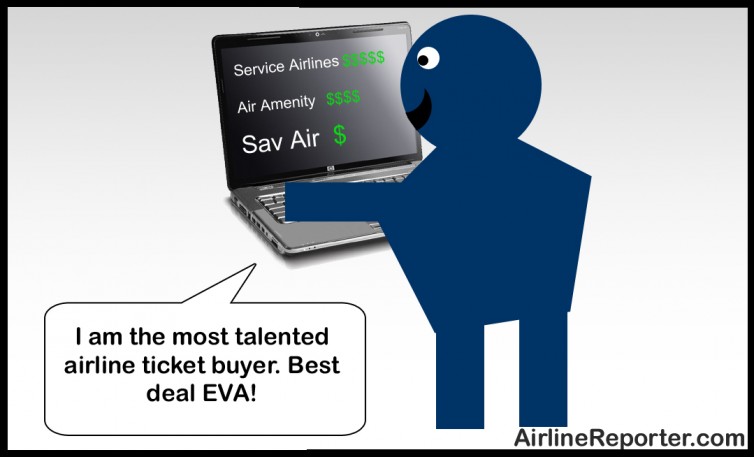
Stage One: The Search
There are many out there who could care less about what airline they fly on — all they care about is price. They remember flying from Los Angeles to Topeka in 1996 for $79.00 round trip and refuse to pay more than that ever again. They will check every airline site possible, spending hours, maybe even days trying to find the best deal possible. Then, amazingly they find one airline with prices way less than their competitors. Why is it so much cheaper? Who the heck cares… for that price, you are willing to fly in a cardboard box! After getting your ticket, you gloat to as many as you can on how much you saved. You title yourself the “Airline Fare Master.” Oh… just wait my friend.
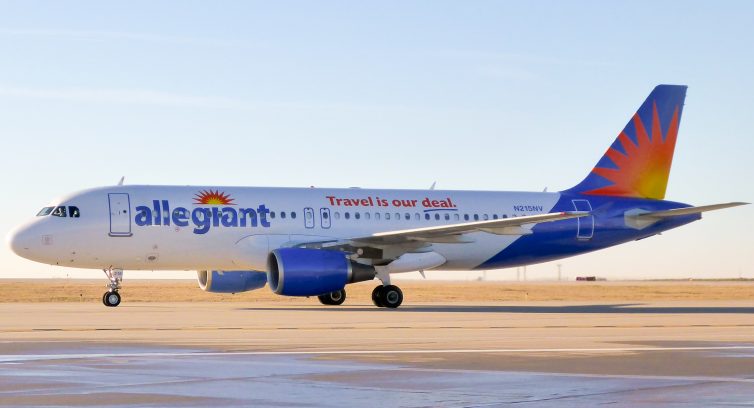
An Allegiant A320 in the current livery, seen at Kansas City International – Photo: C.T. Thongklin
Late last month Allegiant announced plans to acquire twelve new Airbus A320s. Airlines make fleet announcements often, but this one was of particular significance for a number of reasons.
Allegiant’s order for new A320s:
First, this order for brand-new planes, direct from Airbus, signals a change in standard operating procedure for the Las Vegas-based ultra-low-cost carrier (ULCC). Historically, Allegiant had shirked the trend of its ULCC peers, both domestically and abroad, of adopting fuel-efficient, modern aircraft. Instead, the airline has had a well-known preference for less costly mid-to-late life secondhand McDonnell Douglas MD-80 series planes. Cheaper planes equate to lower fares, and higher margins. This concept is not new; many budget carriers have used that model and benefited greatly from it (some have not). Allegiant is no exception. The airline is so well known for this preference, in fact, that few realize that the airline began acquiring Airbus aircraft in 2013. I myself was surprised to learn that the number of available seat miles flown by Allegiant’s Airbus fleet is nearly tied with that of their larger McDonnell Douglas fleet. Jude Bricker, Allegiant Travel Company senior vice president of planning, confirms expectations that the Airbus fleet will tip the scales by the close of 2016.
Older, used Airbus planes are known for being attractively priced. This is something Allegiant saw as early as 2012 when the airline announced plans to acquire its first batch of A319s. Then-President Andrew C. Levy stated, “A319 asset values have significantly declined and now mirror the environment we saw when we first began buying MD-80s.” While Airbus has focused much of its attention on pushing its newer and higher priced NEO (new engine option) models, it seems existing Airbus variants and future current engine option (CEO) deliveries are well positioned to become as ubiquitous as the much loved, budget friendly, long-lived MD-80s they are slowly but steadily replacing.
Allegiant’s newest (employee-approved) livery iteration:
Alongside this announcement, the airline unveiled plans for an incremental livery modification. Two final contenders were chosen, and employees were given an option to vote on which would be adopted.
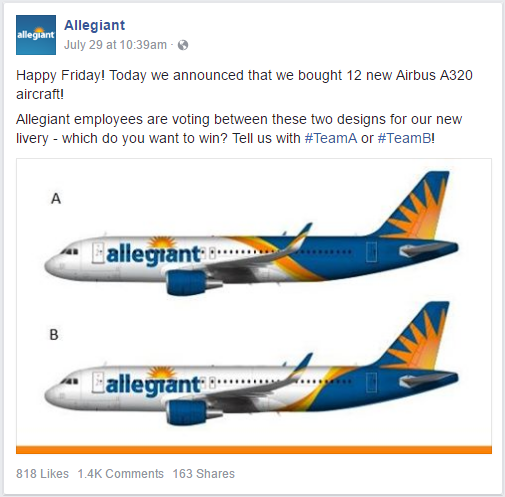
Allegiant announces A320 purchase and new livery candidates – Image: Allegiant’s Facebook
Which did the employees choose?
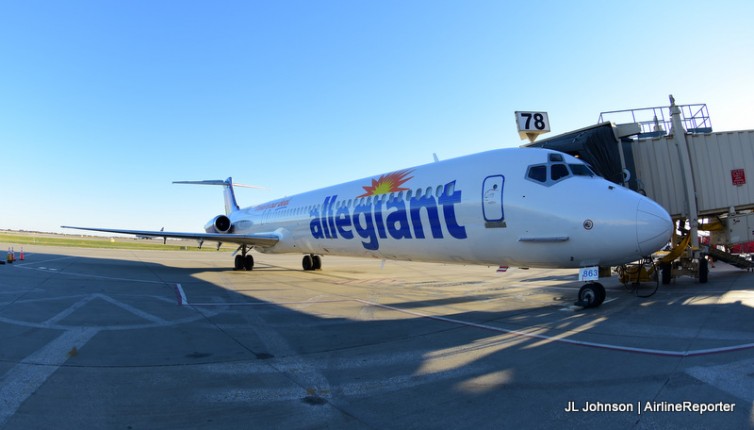
N863GA, a 26-year young MD-83
Earlier this year, I was excited to learn Allegiant would be the newest airline to bring service to my home market here in Kansas City, MO. Allegiant was the last piece of the puzzle to complete the ultra-low-cost carrier (ULCC) trifecta. So, naturally I had to be on their very first flight out.
Just last year Spirit inaugurated services at Kansas City International and in the following months brought with them unprecedented fare disruption across multiple markets. The effects were unlike any I have witnessed in a decade of paying close attention to fare trends in KC. And herein lies the secret with ULCCs; even if passengers never intend to fly with them, they bring normalcy to entire markets with LCCs and even legacies adjusting their own fare structures to keep from losing too much market share.
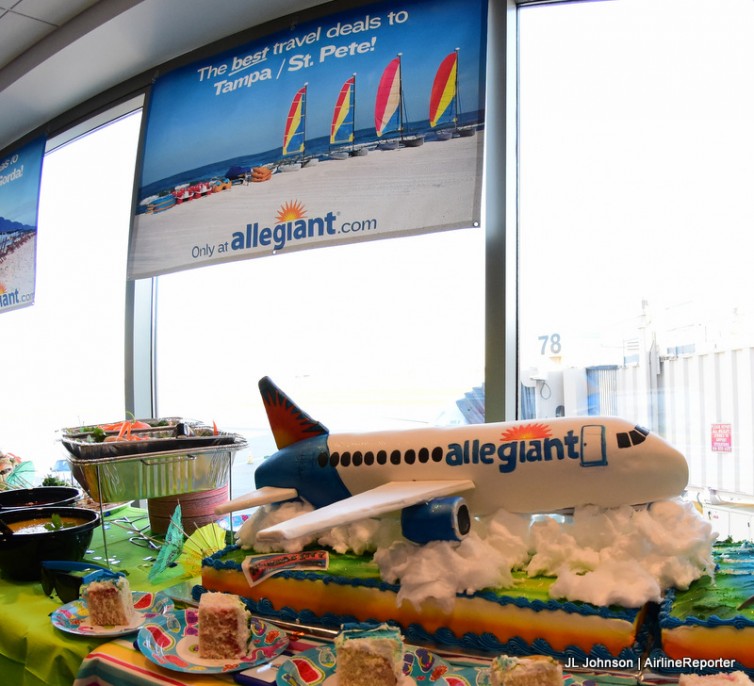
Inaugural Cake! An A319?
New airline aside, I’m a bit of an inaugural hound. When the day came, I elected to skip the press conference and focus on becoming the first confirmed booking, which I’m proud to announce I accomplished, while the press conference was still going, in fact.
As I tend to do, I booked the outbound leg, making a mental note to fill in the rest of the details “later” – I wound up scrambling to find a way home. When I realized I was one week from my trip with no way home, I went to my preferred carrier who wanted nearly $300 one way. This, in contrast to the mere $82 (fare + exit row + carry-on) I paid Allegiant outbound. Reluctantly, I looked elsewhere and found similar prices. I soon realized what began as a one-way experiment with Allegiant would wind up being a round trip with them out of equal parts laziness, frugality, desperation, and curiosity.
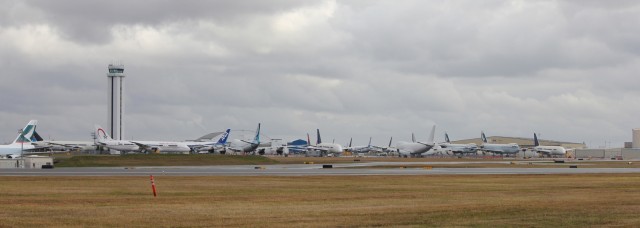
Paine Field (KPAE) already had tons of large planes that are built and flown around the local area.
Last week, the Federal Aviation Administration (FAA) approved commercial flights to operate from Paine Field (KPAE) in Everett, WA. Will that mean flights will actually start at the airport? Maybe not.
Paine Field is located about 30 miles north of Seattle-Tacoma International Airport and is where Boeing builds all 747, 767, 777 and (most) 787 aircraft. Although Boeing dominates the airport, it is owned and operated by Snohomish County and is a public airport.
Allegiant Air raised the commercial service issue at KPAE a few years ago and it has been a struggle since. Initially, Alaska Airlines said it would be interested in operating out of KPAE, then withdrew interest. It has noted that they would start flights if one of their competitors would (ie Allegiant).
Even though this approval passed, do not expect flights to start anytime soon. There is not a passenger terminal and members of the community are expected to sue to stop commercial flights.
PAINE FIELD COMMERCIAL FIGHTS BACKGROUND STORIES:
When the news of the approval surfaced, I emailed to multiple airport/airline contacts to get thoughts and some quotes. The lack of comments surprised me (ones listed as “no comment” actually wrote back to state that they had nothing to say on the matter):
Boeing: “We have no position on it.”
Paine Field: No comment.
Future of Flight: No comment.
Snohomish County Tourism Bureau: No comment.
Seattle-Tacoma International Airport: No comment.
Museum of Flight (Restoration Center at Paine Field): No comment.
Flying Heritage Collection: “FHC is following this issue with interest and we look forward to hearing more as details emerge.”
King County International Airport / Boeing Field: “The decisions at Paine Field have no direct impact on KBFI. As an open-access airport that receives Federal funds, the FAA requires us to evaluate any proposals to do business at the airport without discrimination. Currently, no commercial service companies have expressed an interest.”
Alaska Airlines: (they win for having the most to say) “Adding commercial air service to a regional airport located 42 miles away from the state’s largest airportand an hour’s drive from Bellingham International Airportis not a good alternative for our region. It would also require a multimillion-dollar investment to build a new terminal and other facilities to accommodate passenger service.” They continue with, “if a competitor begins commercial service at Paine Field, we would respond by adding flights using both a Bombardier Q400 turboprop and Boeing 737 jet.” (Read Alaska’s full statement here)
Kenmore Air: “At this time, we don’t see PAE fitting into our current or envisioned route structure. But we’ll definitely be watching developments there with interest.”
Allegiant Air: “The report on Paine Field certainly opens the airport up as a possible opportunity for Allegiant. We are constantly evaluating new cities and new routes that may be a successful addition to our current network. We will keep Paine Field on our radar, but there are no immediate plans for service there.”
The lack of comments, especially from those who are closely related to Paine Field, lead me to think there is much more going on behind the scenes. I can see why Boeing wouldn’t want commercial service traffic in its production airfield, but the commercial service would bring more money to the airport and area businesses. My guess: Politics.
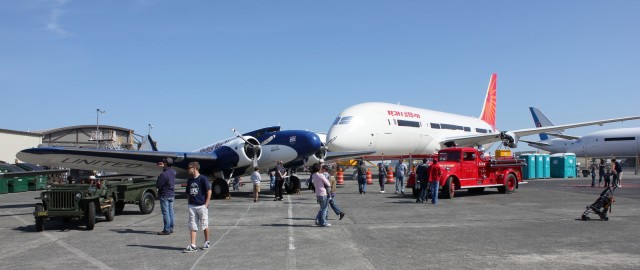
Paine Field Aviation Day 2012 at KPAE. Could events like this be reduced with commercial flights commencing?
Surrounding KPAE are quite a few affluent homes that overlook the water. I am sure that many of those folks do not want the values of their homes to decrease with the initiation of passenger service.
Personally, I have a hard time with stifling community growth. Residences purchased homes knowing that Paine Field existed and could expand. My own home is in the flight path of Paine Field and, even as an AvGeek who would love seeing more planes flying over, having my value decrease obviously doesn’t excite me. However, it’s important to look at the greater good of the community and region at large. Improving the local economy with the job growth a passenger service would provide, in exchange for a few loud MD-80 flyovers, would be a positive trade. I am okay with that. Obviously, most in the area of the airport do not share my sentiment.
Expanding commercial service to the region would mean badly needed economic recovery for many in the area; but many government institutions and politicians are either staying silent or are opposed the additional service. Why? Most likely: Re-Election.
The airport can surely handle the additional traffic. According to the Seattle Times: “The FAA spent three years responding to public comments and studying the impact of 8,340 additional flight operations a year at the airport over five years. The airport is operating now at about a third of its capacity of 350,000 operations a year.”
One of a few politicians who have come out in favor of commercial flights is Everett Mayor Ray Stephanson. ’œThe City of Everett has been on record supporting commercial air at Paine Field for many years now,’ Stephanson said according to KING5. ’œCommercial air is necessary for economic development and job growth. Hopefully we’ll soon be working with a company to provide commercial air at Paine Field.’
Snohomish County has already stated that it has a plan for a two-gate terminal, but it does not plan to spend any of its own money. With there being no terminal, looming litigation, and the fact that no airline is stating it will start commercial service… it is still going to be a few years before you can start flying out of Paine Field on an airline.
Other than Allegiant, I could easily see Spirit Airlines interested in starting operations in the Pacific Northwest. Frontier, who flies seasonally out of Bellingham, might be interested as well. It would be quite interesting to see an airline fly an Airbus product through the airport where the majority of Boeing wide-bodied aircraft are built. Hopefully someday.
 |
This story written by… David Parker Brown, Editor & Founder. David starting AirlineReporter.com in the summer of 2008, but has had a passion for aviation since he was a kid. Born and raised in the Seattle area (where he is currently based) has surely had an influence and he couldn’t imagine living anywhere else in the world.@AirlineReporter | Flickr | YouTube |
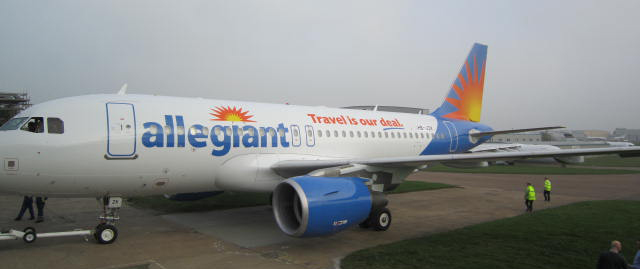
Allegiant’s first Airbus A319 (HB-JZK / N301NV) after being painted to their livery. Image from Allegiant.
Earlier this year, Allegiant Air announced that they would be adding 19 Airbus A319s into their fleet. The one seen in this story was recently painted in United Kingdom Southend (SEN) and previously wore EasyJet colors. It currently shows registration number HB-JZK, but when put into service, this aircraft will most likely be wearing N301NV.
Their first A319 is scheduled to be delivered Q1 2013 and in operations Q2 2013. After it is delivered, the aircraft will be used for crew training.
BONUS: READ MORE ABOUT ALLEGIANT’S AIRBUS A319
Allegiant is configuring their A319’s in a high-density, 156 economy seat layout. The double exit doors over the wing shows that this aircraft is able to handle the 156 configuration (most A319’s with a single exit hold 134 seats).
One thing you might notice in all the photos is it doesn’t include the nose cone. I expect that is because the aircraft does not currently have a nose cone as seen on Skyliner-aviation.de. I am quite confident that it will have one soon.
I have to say that I love Allegiant’s livery. I think it looks best on the Boeing 757 and it is a bit squashed on the A319, but still looks slick.
Thanks Ken for the heads up!
ADDITIONAL ALLEGIANT A319 PHOTOS:
[nggallery id=27]








